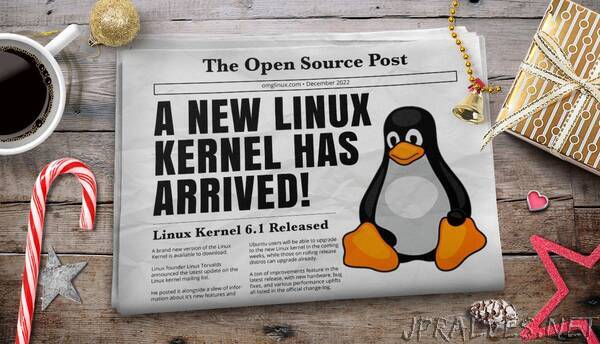
“Linus Torvalds is giving Santa Claus competition as the FOSS-lovin’ Finn is putting the best possible present under the tree this festive season: a brand new Linux kernel.
Yes, Linux kernel 6.1 is here, ready to power the world’s servers, desktops, smartphones, switches, routers, and everything in between. Announcing the arrival on the Linux Kernel Mailing List, Linus Torvalds says: “So here we are, a week late, but last week was nice and slow, and I’m much happier about the state of 6.1 than I was a couple of weeks ago”.
The Linux kernel is developed and maintained by a worldwide community of engineers and enthusiasts. While a great number of those who contribute to the Linux kernel as part of their day job others choose to do so in their free time, of their own accord, and on their own terms.
Let’s take a closer look at what those awesome folks have been up to recently…
Linux Kernel 6.1 Features
A major addition to Linux 6.1 is mainline (experimental) support for Rust, the “multi-paradigm, general-purpose programming language” snowballing momentum across the open source landscape. Though small, this initial batch of bringup makes good on the ambition of letting kernel devs write kernel code in Rust.
Another addition to Linux kernel 6.1 is Multi-Generational Least-Recently-Used (aka MG-LRU; though this not yet enabled by default). To quote in-kernel documentation, this memory-minded feature: “…optimizes page reclaim and improves performance under memory pressure” — hey: better performance is always welcome.
Btrfs user? Linux 6.1 includes a “bunch of performance improvements” to the Btrfs file system performance, including a new block group tree to speed up mount on large filesystems, additional io_uring integration, tweaked sysfs exports; and “outstanding FIEMAP speed improvement”.
Elsewhere, the erofs filesystem is now able to share duplicated data across filesystems; and the EXT4 filesystem benefits from a flurry of fixes, cleanups, and tuneups, the latter including no longer trying to prefetch block allocation bitmaps for read-only file systems.
Also, the PinePhone Pro is now able to run off the mainline Linux 6.1 kernel, as can a suite of older Android smartphones including the Sony Xperia 1 IV, and the Samsung Galaxy E5, E7, and Grand Max. Additionally, there’s now an input driver for the PinePhone keyboard case.
The Nintendo HID driver is now so polished that “cheap clone” controllers will work with it; and the Logitech driver now enables HID++ usage for all Bluetooth devices and, as Phoronix reports, can auto-detect high resolution scrolling ability if supported – strikethrough feature was reverted at the last minute.
A stack of new sound hardware support ships with Linux 6.1, including initial work for sound support on Apple Silico, support for AMD Rembrandt with the Sound Open Firmware (SOF), and support for audio on the Mediatek MT8186 SoC expected to feature in new Chromebooks.
Several new devices gain support from the kernel XPad input driver, including Xbox One Elite paddles on the original Elite and the Elite series 2.
Other devices supported include the Hori Fighting Commander ONE gamepad (including in Xbox mode), the 8BitDo Pro 2 wired controller, and a swathe of Wooting keyboards, including the Wooting One, Two, Two HE and 60HE.
Kernel 6.1 also includes the usual sort of foundation-laying for next-gen CPUs and GPUs. Work in 6.1 includes new driver code for the AMD platform management framework on future Ryzen chips; plumbing for Intel ‘Meteor Lake’ 5nm chips; and continued effort on Intel Arc Graphics DG2/Alchemist.
Other changes:
- Kernel Memory Sanitizer (KMSAN) merged
- More LoongArch CPU support
- Kernel can decompress + launch in architecture-agnostic way on EFI systems
- Faster Intel Memory error decoding via EDAC driver
- Maple Tree data structure support
- New security controls on the ability to create user namespaces
- Kernel will print CPU core where segmentation fault occurs
Overall, Linux kernel 6.1 offers a range of new features and improvements that enhance the performance and security of Linux-based systems. These improvements make Linux an even more powerful and flexible operating system, capable of meeting the demands of a wide range of applications and users.
Want even more info on the latest release? Glance at Phoronix’s feature overview for top-level info, or dive in to the details with the LWN merge report 1 and LWN merge report 2.
Getting Linux 6.1
Linux 6.1 is available to download as source code right now, which you can compile by hand on your distro of choice? Not up for that? Wait for your distro maintainer to package the do the half graft instead.
While some distros (like Arch) package new Linux kernel releases and push them out to users as updates, Ubuntu does not. As a fixed-release distro new kernel releases only ship in new releases, though LTS releases do get periodic new kernel updates back-ported from later releases.
You can try Canonical’s mainline repo to install Linux 6.1 on Ubuntu based distros. This is NOT recommended. Mainline builds do not come with any warranty, support, or testing to ensure they’re issue-free. Use as your own risk.”
